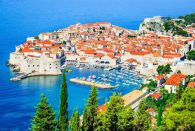You are here: ![]() > Trogir
> THINGS TO DO
> Heritage
> Museums
> Trogir town museum
> Trogir
> THINGS TO DO
> Heritage
> Museums
> Trogir town museum
Town museum
The Trogir Museum was opened in 1966 within a unique complex of several palaces and houses owned by the Garagnin-Fonfogna family since the 18th century. The first small room accommodates a late Greek relief "Woman at Work" (2nd- 1 st century BC), and the replica of Kairos (4th-3rd century BC), as well as the prehistorical finds from the Trogir surroundings and the fragments of ceramics and glass from the Greek period. The Roman period is represented by the finds from the graves (fragments of a helmet, money, amphoras, urns) and stone reliefs and fragments discovered during archeological excavations near Trogir.

The second, large hall with a three-light window presents the medieval Trogir through documentation on development of the autonomous commune. The first printed city Statute from the 1708, which actually governed the city public life already in the 14th century, and the city seal rings are on display in this hall. The original minutes of the City Council sessions from 1316 are displayed, along with major documents on parchment, and the Venetian money used in the provinces of Dalmatia and Albania. Ivan Lucic's "De Regno Dalmatiae et Croatiae", the major medieval Croatian work published in Amsterdam in 1666 is here, along with the matricula of the All Saints brotherhood from 1573, and the testimony on Venetian-Turkish war contained in the memoirs of Koriolan Cipiko (1477). The walls are decorated with the coats of arms of the Trogir nobles, and the fascinating wooden cock, the trophy of Alviz Ćipiko from the battle of Lepanto (1571) dominates the space. The salon is furnished with original furniture and household objects from the 17th and 18th centuries, portraits of the Trogir aristocracy, arms and armor from the battles with Turks. The forth large hall holds city documents from the days of the French occupation until the beginning of the twentieth century. The fifth hall houses etnographic collection of object from Trogir and its surroundings. The famous historical Garagnin-Fanfogna library with about 5,500 volumes is also part of the Museum. It contains incunabula and many parchments and archive material. The famous document "Pacta conventa" (Qualiter), particularly important for the history of the Croatian and Hungarian relations, has been found in this library. The Municipal Stone Monuments Collection (Lapidarij) is placed at the ground section of the palace. It holds conserved archeological finds which clearly illustrate the earliest stages of the city development through preserved foundations of prehistorical, Greek and Roman and late ancient buildings. This Collection holds interestingly set up stone monuments of the Trogir history, arranged in chronological order from the ancient times to Baroque. Particularly valuable are the Renaissance sculptures of Nikola Firentinac and Ivan Duknovic from Trogir. In 1978, the gallery of paintings by Cata Dujsin-Ribar was open upstairs, displaying numerous works this painter had donated to her native city.Collection of religious art is set up in the abbey of St. John the Baptist (Pinacotheca). The collection includes great works of art by masters of chisel and brush, and precious embroidered church robes, books and other valuables. The faint traces of frescoes on the walls and the oldest 14th century tombstone in Dalmatia with the image of the deceased are also valuable showpieces. The most complete collection of the famous Gothic painter Blaz Jurjev Trogiranin is placed here. Two of his polyptychs (the one with St. Jacob as the central figure bears the only known painter's signature) and the painting of Our Lady in the Rose Garden, the matricula of the brotherhood of the Holy Spirit (whose head he was) illuminated by him, are all exhibited here. The collection is predominated by a large painted crucifix of the Dalmatian school from the second half of the 15th century, probably the work of Blaz Jurjev. Along with the works by Paolo Veneziano, Quirizio da Murano, Gentille Bellini, Dujam Vuskovic and others, impressive is the tomb of the Cipiko family, with excellent relief of the lament over Christ by Nikola Firentinac. The showcases contain miniatures of illuminated lectionaries, missals and evangelistaries from the 12th and 13th centuries. The statue of St. John the Baptist is the plaster cast of the work of the sculptor Ivan Mestrovic, while the bronze original is in the Split baptistry.





 Join us for free on Trogir walking tour
Join us for free on Trogir walking tour
 10% discount on day excursions from our offer
10% discount on day excursions from our offer
 15% discount on rental service
15% discount on rental service














